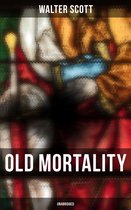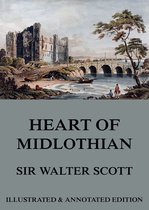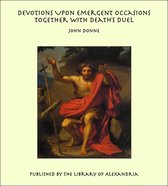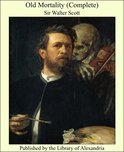Old Mortality (Complete) Ebook Tooltip Ebooks kunnen worden gelezen op uw computer en op daarvoor geschikte e-readers.
Afbeeldingen
Sla de afbeeldingen overArtikel vergelijken
- Engels
- E-book
- 9781465535078
- 24 februari 2021
- Adobe ePub
Walter Scott
Samenvatting
The origin of "Old Mortality," perhaps the best of Scott's historical romances, is well known. In May, 1816, Mr. Joseph Train, the gauger from Galloway, breakfasted with Scott in Castle Street. He brought gifts in his hand,—a relic of Rob Roy, and a parcel of traditions. Among these was a letter from Mr. Broadfoot, schoolmaster in Pennington, who facetiously signed himself "Clashbottom." To cleish, or clash, is to "flog," in Scots. From Mr. Broadfoot's joke arose Jedediah Cleishbotham, the dominie of Gandercleugh; the real place of Broadfoot's revels was the Shoulder of Mutton Inn, at Newton Stewart. Mr. Train, much pleased with the antiques in "the den" of Castle Street, was particularly charmed by that portrait of Claverhouse which now hangs on the staircase of the study at Abbotsford. Scott expressed the Cavalier opinions about Dundee, which were new to Mr. Train, who had been bred in the rural tradition of "Bloody Claver'se." [The Editor's first acquaintance with Claverhouse was obtained through an old nurse, who had lived on a farm beside a burn where, she said, the skulls of Covenanters shot by Bloody Claver'se were still occasionally found. The stream was a tributary of the Ettrick.] "Might he not," asked Mr. Train, "be made, in good hands, the hero of a national romance as interesting as any about either Wallace or Prince Charlie?" He suggested that the story should be delivered "as if from the mouth of Old Mortality." This probably recalled to Scott his own meeting with Old Mortality in Dunnottar Churchyard, as described in the Introduction to the novel. The account of the pilgrim, as given by Sir Walter from Mr. Train's memoranda, needs no addition. About Old Mortality's son, John, who went to America in 1776 (? 1774), and settled in Baltimore, a curious romantic myth has gathered. Mr. Train told Scott more, as his manuscript at Abbotsford shows, than Scott printed. According to Mr. Train, John Paterson, of Baltimore, had a son Robert and a daughter Elizabeth. Robert married an American lady, who, after his decease, was married to the Marquis of Wellesley. Elizabeth married Jerome Bonaparte! Sir Walter distrusted these legends, though derived from a Scotch descendant of Old Mortality. Mr. Ramage, in March, 1871, wrote to "Notes and Queries" dispelling the myth. According to Jerome Bonaparte's descendant, Madame Bonaparte, her family were Pattersons, not Patersons. Her Baltimore ancestor's will is extant, has been examined by Old Mortality's great-grandson, and announces in a kind of preamble that the testator was a native of Donegal; his Christian name was William ("Notes and Queries," Fourth Series, vol. vii. p. 219, and Fifth Series, August, 1874). This, of course, quite settles the question; but the legend is still current among American descendants of the old Roxburghshire wanderer
Productspecificaties
Inhoud
- Taal
- en
- Bindwijze
- E-book
- Oorspronkelijke releasedatum
- 24 februari 2021
- Ebook Formaat
- Adobe ePub
- Illustraties
- Nee
Betrokkenen
- Hoofdauteur
- Walter Scott
- Tweede Auteur
- Walter Scott
- Hoofduitgeverij
- Library Of Alexandria
Lees mogelijkheden
- Lees dit ebook op
- Android (smartphone en tablet) | Kobo e-reader | Desktop (Mac en Windows) | iOS (smartphone en tablet) | Windows (smartphone en tablet)
Overige kenmerken
- Studieboek
- Nee
EAN
- EAN
- 9781465535078
Je vindt dit artikel in
- Categorieën
- Taal
- Engels
- Boek, ebook of luisterboek?
- Ebook
- Beschikbaar in Kobo Plus
- Beschikbaar in Kobo Plus
- Beschikbaarheid
- Leverbaar
Kies gewenste uitvoering
Prijsinformatie en bestellen
De prijs van dit product is 4 euro en 99 cent.- E-book is direct beschikbaar na aankoop
- E-books lezen is voordelig
- Dag en nacht klantenservice
- Veilig betalen
Alle bindwijzen en edities (2)
-
4,99Direct beschikbaar
-
0,97Direct beschikbaar
Rapporteer dit artikel
Je wilt melding doen van illegale inhoud over dit artikel:
- Ik wil melding doen als klant
- Ik wil melding doen als autoriteit of trusted flagger
- Ik wil melding doen als partner
- Ik wil melding doen als merkhouder
Geen klant, autoriteit, trusted flagger, merkhouder of partner? Gebruik dan onderstaande link om melding te doen.










